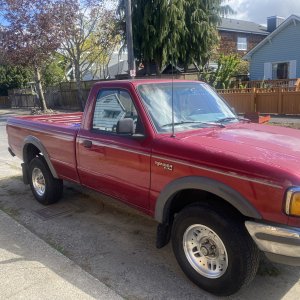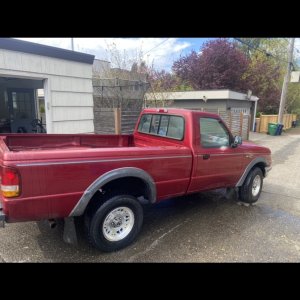Fords4Us
Member
- Joined
- Dec 27, 2012
- Messages
- 51
- Reaction score
- 2
- Points
- 8
- Location
- Snohomish, WA
- Vehicle Year
- 1983
- Make / Model
- Ford Ranger
- Engine Size
- 2.8L
- Transmission
- Manual
Good morning all, and thanks for such a great forum. This is my first post.
We have a 1983 Ford Ranger, 2.8L engine with the 2bbl Motorcraft carb, standard shift, 100% stock as far as I know. She's a hard worker as a farm truck, and we try to keep up with typical maintenance needs. But lately she's been struggling. Rough cold idle, so rough that she stalls out if I don't keep the gas pedal slightly down. Then the idle runs super-high during warmup, even after goosing the gas pedal. Super-thick exhaust also during cold start, and fuel efficiency went into the toilet. When we first had these issues a few years back, the shop replaced the choke thermostat. That helped for awhile but the problems came back pretty quickly, and fuel efficiency went from never-that-great down to terrible. Everything pointed to a carb that needed a good cleaning and possibly some adjustments for the idling.
During the carb teardown, we found something interesting. Towards the end of the teardown, after we'd taken all the topside stuff off and flipped it over, we removed the spacer plate and found sludge caked into one of the carb's compartments. This is the lower half of the carb, at the back of the engine compartment, the corner aiming towards the driver's side. Everything in that corner was chock full of sludge. The vacuum line going out to the passenger side valve cover was open and clear, but the point where that vacuum line came into the carb was completely blocked by that sludge.
We also saw signs that a lot of oil had been blowing through the PCV valve. Our theory is that somehow that vacuum line coming off the carb to the passenger side valve cover got blocked somehow, either at the valve cover end or the carb end, creating a blockage in that carb compartment and creating an air dam in the line. Question is, WHY? I have the sinking feeling that we're going to have to pull the valve cover and see what's going on within that half of the engine. Does anyone have any ideas why this is happening?
Kathryn Kerby
frogchorusfarm.com
Snohomish, WA
We have a 1983 Ford Ranger, 2.8L engine with the 2bbl Motorcraft carb, standard shift, 100% stock as far as I know. She's a hard worker as a farm truck, and we try to keep up with typical maintenance needs. But lately she's been struggling. Rough cold idle, so rough that she stalls out if I don't keep the gas pedal slightly down. Then the idle runs super-high during warmup, even after goosing the gas pedal. Super-thick exhaust also during cold start, and fuel efficiency went into the toilet. When we first had these issues a few years back, the shop replaced the choke thermostat. That helped for awhile but the problems came back pretty quickly, and fuel efficiency went from never-that-great down to terrible. Everything pointed to a carb that needed a good cleaning and possibly some adjustments for the idling.
During the carb teardown, we found something interesting. Towards the end of the teardown, after we'd taken all the topside stuff off and flipped it over, we removed the spacer plate and found sludge caked into one of the carb's compartments. This is the lower half of the carb, at the back of the engine compartment, the corner aiming towards the driver's side. Everything in that corner was chock full of sludge. The vacuum line going out to the passenger side valve cover was open and clear, but the point where that vacuum line came into the carb was completely blocked by that sludge.
We also saw signs that a lot of oil had been blowing through the PCV valve. Our theory is that somehow that vacuum line coming off the carb to the passenger side valve cover got blocked somehow, either at the valve cover end or the carb end, creating a blockage in that carb compartment and creating an air dam in the line. Question is, WHY? I have the sinking feeling that we're going to have to pull the valve cover and see what's going on within that half of the engine. Does anyone have any ideas why this is happening?
Kathryn Kerby
frogchorusfarm.com
Snohomish, WA














